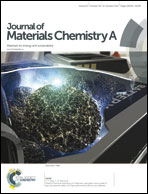Thin film nanocomposite (TFN) hollow fiber membranes incorporated with functionalized acid-activated bentonite (ABn-NH) clay: towards enhancement of water vapor permeance and selectivity†
Abstract
As the use of membrane technology for gas separation has grown, various membrane materials have been developed by numerous researchers to demonstrate separation processes. The present study was intended to make a novel thin film nanocomposite (TFN) membrane hybridized with amino functionalized acid-activated bentonite (ABn-NH) clay. It was projected that the ABn-NH-TFN membranes could improve water vapor permeation performance. The present work was done paying attention to how the incorporation of ABn-NH could affect the TFN membrane physicochemical properties and permeation performance. Thin films of ABn-NH-TFN membranes were prepared using interfacial polymerization on the inner surface of a polysulfone (PSf) hollow-fiber membrane support for the separation of a water vapor/N2 gas mixture. The prepared material and thin film composite membranes were fully characterized using physicochemical techniques including X-ray diffraction, BET surface analysis, thermal gravimetric analysis (TGA), Fourier transform infrared (FTIR) spectroscopy, scanning electron microscopy (SEM), atomic force microscopy (AFM) and contact angle analysis. The concentration effect of ABn-NH clay (0–1.0 wt%) on the permeation of water vapor and N2 was investigated. According to SEM images of the composite membranes, 0.5 wt% of ABn-NH clay particles shows good dispersion on a thin selective layer. Water vapor permeation results showed that with the incorporation of ABn-NH particles into the polyamide membrane, the permeance increases enormously. The most advantageous performance, that of ABn-NH-TFN-3 (0.5 wt%) membrane, was achieved with a water vapor permeance of 2809 GPU and a water vapor/N2 selectivity of 913, with a membrane prepared with 2.0 wt% MPD and 0.2 wt% TMC monomer concentrations of coating solution.



 Please wait while we load your content...
Please wait while we load your content...